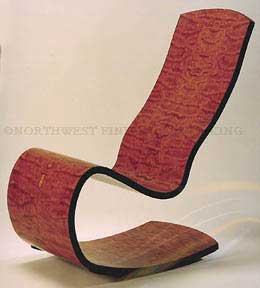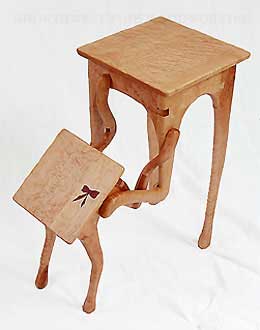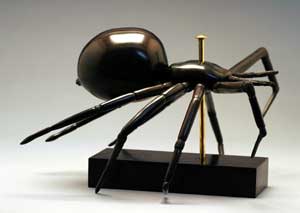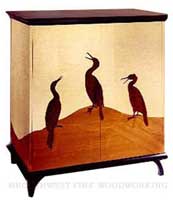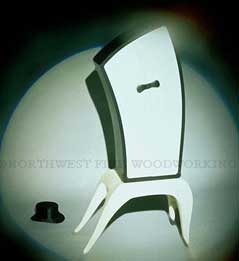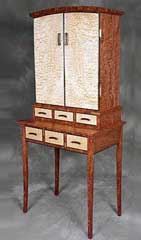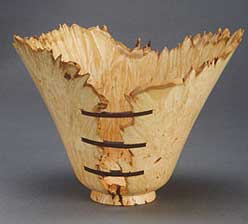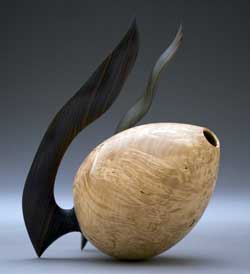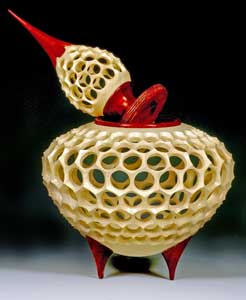
For skilled woodworkers of the Pacific Northwest, perhaps the most sought-after gallery for exhibition and sale is NW Fine Woodworking. Entry into this upscale gallery, situated in Seattle’s historic Pioneer Square, is by jury acceptance. Walking through its well-lit areas provides a feast of some of the finest studio furniture to be found anywhere in the country, but now, thanks to a troubled economy, it is shrinking. However, with the grit typical of woodworkers, the members of this cooperative are determined to keep it going. Oddly enough, the path they’ve chosen to keep it alive is to have it return to its roots.
To get the history of this fine gallery, I spoke with Sharon Ricci, who started working there in 2004. “Until I became a mom, I was a trained woodworker,” Sharon explained, ” but I was not all that fond of the big machinery, and felt I was neither talented nor patient enough to be a member here.” Instead, she became the pivotal employee keeping the gallery humming. Thus, it was with bittersweet irony that she informed me that I had reached her on her last day on the job. Along with all the other employees there, she was being downsized. To take up the slack, the co-op members would now each put in time staffing the gallery, just as they had at its inception.
“NW Fine Woodworking was started in 1980 by a group of 11 local Seattle furniture makers,” Sharon told me. “They wanted to have their own work spaces, but wanted to join forces for marketing and to share a gallery in downtown Seattle. Initially, all of them worked in the store in the fashion of a true co-op.
“They immediately started adding more members. By the end of the first year, there were about 20 members, and each spent time working in the gallery. They realized, in about a year, that they were all better at woodworking than gallery sales, so they brought in their first employee, a salesperson and store manager named Sheryl Peterson.
“As the business grew, they moved twice: the last time in 1995 to an ideal space with an excellent ground floor corner location, good lighting and an interior designed and built by the members. The number of members has varied over the years, at one point going near 30 members. Today it stands at 18 members, in large part because business has gotten tough. Everyone kicks in fees for costs, marketing and promotions. Along the way, the range expanded well beyond Seattle and Washington, adding out-of-state members.
“They also started accepting work for the gallery from woodworkers who are not members, pending acceptance by a jury of the members. For a while, we had about 200 non-member artisans showing at the gallery, though at present we are down to about 25. To exhibit here, you must be either an individual or a two-person team, not a shop, and must be from the Pacific Northwest (PNW). That includes anywhere from British Columbia in Canada, south to Northern California, and east to the Rocky Mountains.
“We only accept original designs. There are no reproductions permitted, though certainly influences from other builders do show up. We feel the work from this area has a specific esthetic, often with Scandinavian and Asian influences. Of course, it is not a requirement that pieces follow those influences, merely that the artisans be working in the PNW. Nevertheless, if you wander the gallery you will notice that as a whole, there is a very different feel to the bulk of the work than you would see in a gallery in the Northeast. Our designers tend to use woods in their natural colors with very natural looking finishes. They are into the natural beauty of the wood being enhanced through their design.
“The jury tends to encourage people just starting out, and those people often do not have a personal esthetic yet. But to be invited to be a member, there must be something more. For that, we look for woodworkers who have a voice of their own as evinced by their design and work. Quality is also important; the things we are looking for are those that will be tomorrow’s antiques. We expect the pieces to hold up and be built with durable materials, methods and finishes. In that way, we are a very green gallery. Pieces that are well designed, will be used long and will hold up, are also ones that will not be soon replaced. What’s more green than that?
“Generally, the jury will pass over pieces with metal fasteners in favor of traditional joinery, like mortise and tenon. Of course, if there is a good reason for a metal fastener, and good art embodied in it, that would be accepted, but not as a mere shortcut. There is definitely a core value that has kept this group together for this long. That’s no easy task for a group of artists, but for this group, the handcrafted way of doing things is endemic to their value.
“The jury process is one of the most interesting activities to experience. Hearing two jury members argue for and against a particular design or construction method is fascinating, and the critique the jury returns to the builder is most helpful. You get a critique whether your work is accepted or not. Sometimes no critique is needed, and very little is written. At times, the jury may agree the piece is wonderful, but still have questions as to just why the artisan did what he or she did in a particular way. The answers to those questions, when the woodworkers offer them, are most interesting.
“For years the gallery was successful, especially during the age of big-scale homes. Big houses and a lot of disposable income meant people would define their home by the furniture they put in it, and that often meant custom pieces. These days, the well-off are still choosing artful pieces, but often smaller ones and fewer of them to fit a more compact home lifestyle.
“As tourism from the East Coast and the Pacific Rim has waned this past year, sales have shrunk. We always focused our advertising and promotion locally, here in the PNW. To compensate for what was happening, we felt we would have to switch to national advertising, but that has not happened. What has happened is that we have been forced to cut back. Our sales are down 30 percent, and because of a new building owner, our rent and building related expenses are up 20 percent. We thinned the staff as much as we could and finally were reduced to three people. As of today, I will be leaving, and the other two will be working only part-time.
“If the artists can fill in the gaps until the economy gets better, we have a chance and can build up again. Last fall we had a wonderful show called ‘Meet Your Maker’ in which the artists met and engaged with the customers. That helped customers understand not only the pieces themselves, but also the makers and why they are doing what they do.
“In a way, we have come full circle: the woodworkers themselves will now be coming in to deal directly with the customers, the way it was at the beginning. On one hand, it is beautiful to see them come together and work this way, but it would be sad if this noble venture did not survive.”
